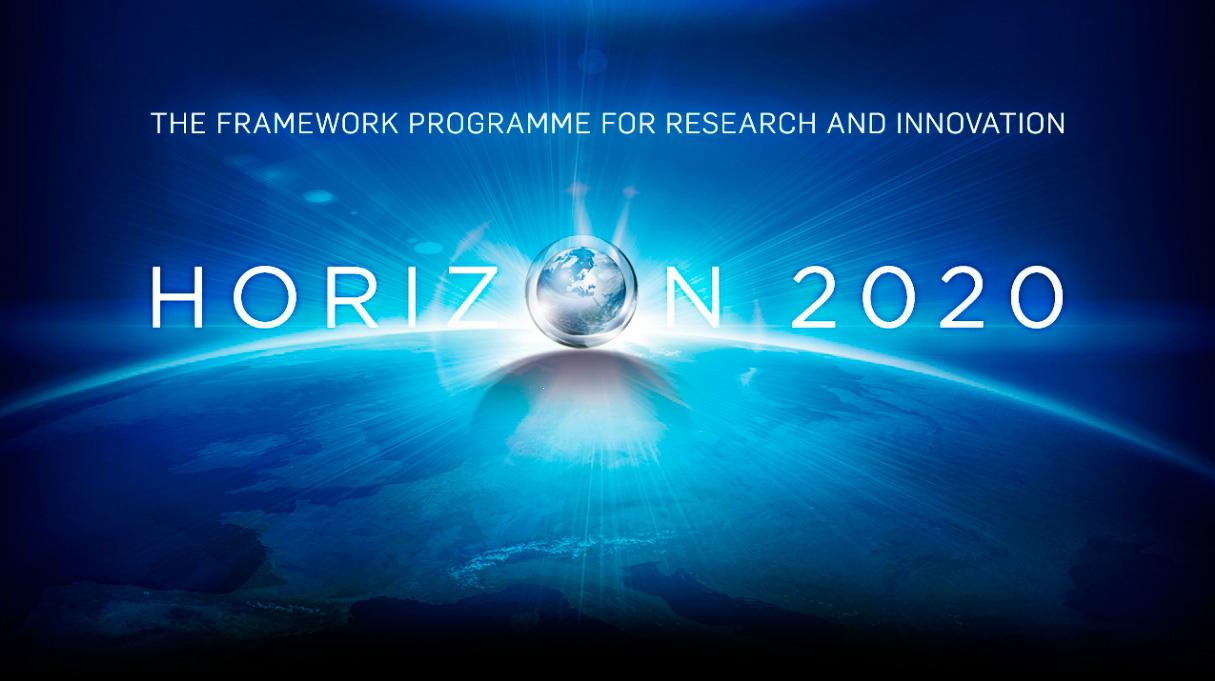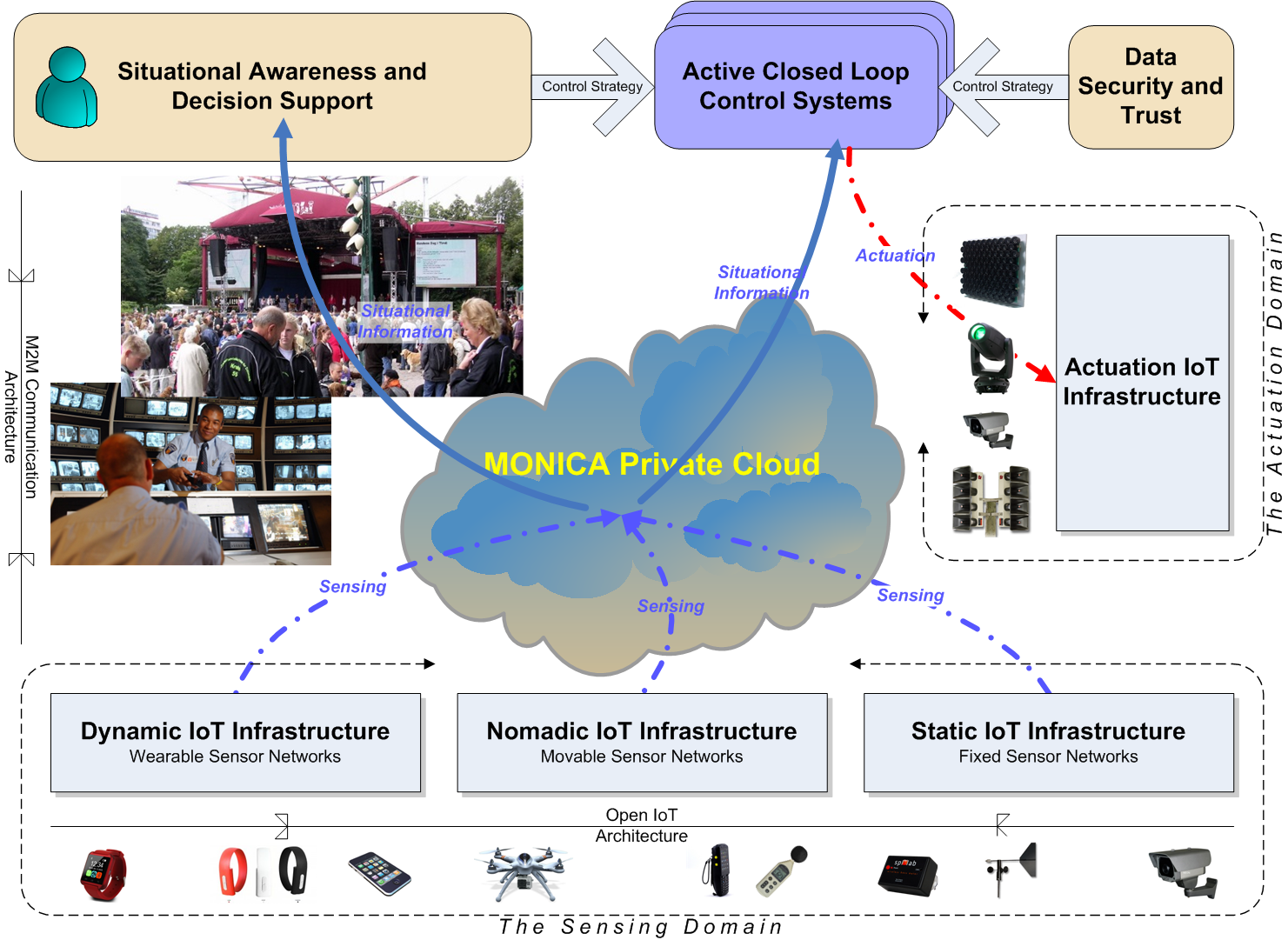Navigation
Share this Subscribe to our mailing listArticles Hierarchy
MONICA
 |
MONICA Management Of Networked IoT Wearables –Very Large Scale Demonstration of Cultural & Security Applications |
EU project (H2020 IA) Start January 2017 Finish December 2019 www.monica-project.eu |
|
The MONICA project is a 36 month Innovation Action (IA) co-funded by the European Commission through the Horizon 2020 Framework Programme for Research and Innovation under the Large Scale Pilots objective Pilot 3: Wearables for smart ecosystems. The project aims to provide a very large scale demonstration of multiple existing and new Internet of Things technologies for Smarter Living. MONICA demonstrates a large scale IoT ecosystem that uses innovative wearable and portable IoT sensors and actuators with closed-loop back-end services integrated into an interoperable, cloud-based platform capable of offering a multitude of simultaneous, targeted applications. It is one of the largest scale IoT platform demonstrations ever thanks to cheap wearables and legacy Smartphones. MONICA embraces a large number of IoT enablers aligned with AIOTI (Alliance of IoT Innovation) and IOT-A. It is demonstrated with a highly relevant IoT application in public safety at big events, where the cheap devices are needed because of the large masses of people. The demonstrators are aligned with Smart City noise, which is well known in many IoT demonstrators. The solution will be deployed in 6 major cities in Europe. All ecosystems will be demonstrated in the scope of large scale city events, but have general applicability for dynamically deploying Smart City applications in many fixed locations such as airports, main traffic arterials, and construction sites. Moreover, it is inherent in the MONICA approach to identify the official standardisation potential areas in all stages of the project. Rationale The MONICA approach aims to demonstrate an IoT platform in the context of multiple existing and novel Internet of Things technologies for Smarter Living and supporting an extremely large number of uses compared to existing demonstration projects. At the same time, the approach will demonstrate solutions in the context of real societal challenges related to security and safety of citizens in the public space, the right to express and pursue European cultural values, and the concern for environmental and safety issues associated with large events held in inner cities. In this sense, the MONICA pilots are autonomous and will be able to select those services and applications from the MONICA platform that suits their specific needs. The relevance of the MONICA approach can be expressed in these different contexts. The context of societal challenges and Smart Cities Sustainable urban development is recognised as a key challenge at the global level. The “Mapping Smart Cities in EU” report issued by ITRE (Industry, Research and Energy Committee) of the European Parliament points out that more than half of all European cities with more than 100,000 residents have implemented or planned measures to have “smarter” cities . The report defines six elements of Smart City characteristics: “Smart Governance, Smart Economy, Smart Mobility, Smart Environment, Smart People, and Smart Living. Smart Living, the subject of MONICA, is defined as: ICT that enabled life styles, behaviour and consumption. It is also healthy and safe living in a culturally vibrant city with diverse cultural facilities, and incorporates good quality housing and accommodation. A Smart City is also a lively city; a cultural city; a city worth living in. A pinnacle in the European way of life and our whole society is precisely the love for culture; developed and refined over many centuries; effectively diffused to the most remote part of our continent; appreciated by all age groups; recognised in one form or the other by all citizens of Europe; and last, but not least, the envy of most other parts of the world since the renaissance period started in the beginning of the 14th century - says Martin Schultz, President of the European Parliament: Europe has a shared history and a richly diverse cultural heritage. This heritage is cherished by the people as a common value that gives our Union its identity and binds us together. That is why Europe must do everything in its power to preserve that heritage in a political and economic climate that is subject to major upheavals. The “European Culture” takes many forms and is expressed in millions of ways. Our project will focus on one of the key aspects of European Culture: The cultural performances in open-air settings, with special focus on musical expression. Music is one of the fundamental pillars of European Culture, in particular the open air performance of music. Open air musical events are not only cultural light-houses; they are also big business. The global Cultural and Creative Industries generate annual revenues of US$2,250b and provide 29.5 million jobs worldwide . The music industry in Europe alone had a turnover of $25,3b and employs 1,2m, a large part of which are between 15 and 29 years of age demonstrating that the cultural and creative sectors are highly attractive for young people. However, this arch-European cultural element is coming under pressure for the reason of safety (e.g. Lyon, Bonn, Leeds) or because of rising property costs in inner cities has made the neighbours less positive towards noise and congestion from open air concerts (e.g. Torino, Copenhagen, Hamburg). The context of Internet of Things platforms Most of the IoT and Smart City platforms are still insufficiently developed to handle really large scale deployment. Health and smart living may potentially involve thousands of users, but they are relatively scarcely distributed, even within a city, and the communication load is limited. Useful traffic applications for easing congestion and pollution may have very high communication load on the IoT network, but the number of objects is relatively small. In response, the MONICA platform will demonstrate a resilient IoT platform that addresses all of the above issues: Scaling, costs of sensors, and intelligence. On this background, the MONICA project is uniquely innovative since it will demonstrate an extremely large uptake of a multitude of IoT applications (10,000+ simultaneous and more than 100,000 different users) using low-costs wearables and apps running on existing wearable platforms such as smart watches and smart phones in combination with wearable sensors. Architecture The MONICA platform is built on several IoT physical world network infrastructures and a closed loop control system for each application. The components are connected via dedicated communication network and data repositories. The entire solution is embedded in a MONICA Private Cloud structure as visualised in Figure 1.
Technology Features Security Applications Behavioral modeling in given contexts will be created using MONICA recordings and incident reporting. Pinpointing of an anomaly at a location in a potentially crowded location will trigger either security or drone deployment for assessing situation. Visual and vibration clues to guide a person, group of people or crowd to a safer location, away from an incident, will be implemented on smartphones and for wristbands. Salient clips (audio/video/etc.) will be stored for post processing or situation assessment carried out by security guards or police or medical/legal investigator (forensic evidence). Heat maps will be created, representing the event and dynamics thereof. This is envisaged after combination of evidence from all processing units and dealt with at a central location/control station for the event Adaptive Sound Field Control System In order to reduce the sound levels outside the direct concert area, an Adaptive Sound Field Control system will be deployed, using the concept of Sound Zones. The idea is to maximise the ratio of the acoustic energy in a ‘bright’ (ensonified) zone to the acoustic energy in a ‘dark’ (quiet) zone with a given source configuration. Pilot Features Each of the six pilots will undertake demonstrations during at least four large events according to their own priorities. The planned pilot events constitute a realistic blend of one-off city events A total of 41 events are scheduled with a total of 108.000 participants and 35.000 neighbours. With 10% of the participants expected to participate in the validation activities, the platform will be evaluated and validated with 14.300 users; affected by the MONICA demonstrators in one way or the other. This is believed to be statistically significant for comprehensive impact analysis and conclusions with regard to user acceptability and sustainability.
|
||
| Expected Project Outcomes These very large demonstrations validated with 14.000+ users will create impact across the full value chain: from supply-side actors like the telecom industry to demand-side actors like cultural event organisers, cities & the public at large. The most significant impact will be created by the mere size of the validated demonstrations – 143.000 end-users over two years. It will be significant in the areas of IoT technologies, user acceptance, and socio-economic performance. The fulfillment of the projects KPIs will demonstrate the MONICA platform as a case of Best Practice of IoT deployment. The project will also develop, validate and publish a range of new business model proposals based on the new values created by the IoT platform for all involved actors to explore. Market analysis for the tourism industry will show new business opportunities for this important industry. Finally, the interoperability of the MONCA platform and technologies with other Smart City platform will ensure its sustainability beyond the project. |
||
| In-JeT’s role in the project In-JeT has several important roles in the project. IN-JET engages in all aspects of user and stakeholder involvement internally, and externally. IN-JET is the project’s Pilot Coordinator and Innovator and is responsible for the coordination of the pilot execution and the outward activities to the external stakeholders. IN-JET is also responsible for impact assessment and validation. Further, IN-JET will be involved in ethics and privacy related to the pilots user and will lead the citizen engagement activities and the work on business models and to market analysis. Finally, IN-JET is responsible for dissemination and communication, and will provide the project’s marketing material and website, and host the webinar platform. |
||
| Partners Fraunhofer-Gesellschaft Angewandte Informationstechnik (Coordinator) AcouCité observatoire de l’environnement sonore du Lyon (Pilot owner) Atos IT Solutions and Services Brüel & Kjær Sound & Vibration Measurements City of Bonn (Pilot owner) Informatics and Telematics Institute/CERTH CNet Svenska AB Dexels BV DigiSky S.r.l. UAV & Robotic systems Technical University of Denmark, Electrical Engineering Stadt Hamburg (Pilot owner) Hamburg University of Applied Science HW Communications Ltd. In-JeT ApS ISMB Istituto Superiore Mario Boella Copenhagen Municipality Kingston University, Computer Science & Mathematics Leeds Becket University Movement Entertainment Srl Optinvent SA Praesidio Group Ring Advocacy Telecom Italia Tivoli A/S (Pilot owner) Comune di Torino (Pilot owner) VCA Technology Ltd. Vaeksthus Zealand Yorkshire County Cricket Club (Pilot owner) |
||
| Funding Co-funded by the European Commission Horizon 2020 research and innovation programme under grant agreement No 732350 https://ec.europa.eu/programmes/horizon2020/ Project budget: 17.6 m€ Project funding: 15.0 m€ Project start date: 1 January 2017 Project end date: 31 December 2019 |
 |
|
|
|
||




